Alane Adams's Blog, page 2
February 15, 2018
Alane Adams Winter Olympic Champions

In the spirit of this month’s Winter Olympics, I wanted to share my thoughts on what I consider medal-winning series for middlegraders that you might not yet have heard of. Of course everyone on the planet is familiar with Harry Potter and Percy Jackson. But what are some other podium-worthy series?
I present to you Alane Adams Winter Olympic Champions!
Gold Medal
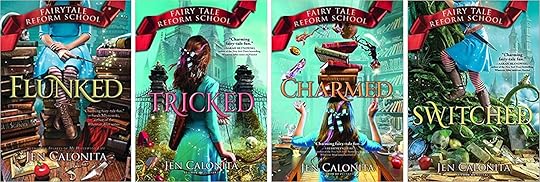
The Fairy Tale Reform School series is one of my favorite middle grade series featuring the heroic pickpocket Gilly Cobbler. This twisted fairy tale from the award-winning author Jen Calonita is a delightfully magical adventure featuring villains as teachers and lots of mixed up fairytales.
“Gilly wouldn’t call herself wicked, exactly…but when you have five little brothers and sisters and live in a run-down boot, you have to get creative to make ends meet. Gilly’s a pretty good thief (if she does say so herself).
Until she gets caught.
Gilly’s sentenced to three months at Fairy Tale Reform School where all of the teachers are former (super-scary) villains like the Big Bad Wolf, the Evil Queen, and Cinderella’s Wicked Stepmother. Harsh. But when she meets fellow students Jax and Kayla, she learns there’s more to this school than its heroic mission. There’s a battle brewing and Gilly has to wonder just how good these bad guys really are?” –Amazon
Silver Medal
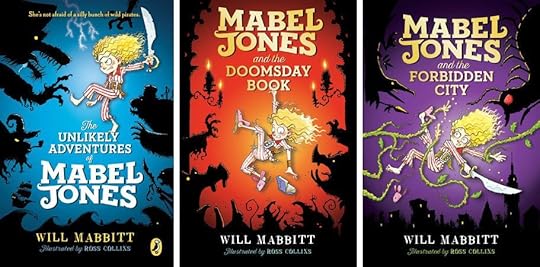
Gr 4 Up–If your kids like Lemony Snicket’s Series of Unfortunate Events then they’ll probably fall in love with Mabel Jone’s spunk and sassiness. Plus the illustrations are charming and will draw in reluctant readers who can engage quickly visually as well as being spellbound by the antics of Mabel Jones.
“When Mabel Jones unknowingly commits ‘The Deed’ she finds herself swiftly bundled into a sack and carried off to the pirate ship the Feroshus Maggot.
Crewed by the strangest bunch of pirates you would ever want to meet and captained by the dreaded Idryss Ebeneezer Split (a wolf with a false leg carved from a human thighbone, a rusty cutlass sheathed in his belt and a loaded pistol tucked in his pants with no fear of the consequences), the Feroshus Maggot whisks Mabel Jones off on the adventure of a lifetime.”–Amazon
Bronze Medal

Given I’m a huge fan of stories with witches, it should be no surprise that this made the list. Especially because the premise is there is no such thing as a good witch! Which means we know exactly where we’re headed: to prove them wrong. This story is definitely darker than some (her mother was hanged as a witch when she was five!) but shouldn’t deter readers from diving into the twisting plot.
“When Kara Westfall was five years old, her mother was convicted of the worst of all crimes: witchcraft. Years later, Kara and her little brother, Taff, are still shunned by the people of their village, who believe that nothing is more evil than magic…except, perhaps, the mysterious forest that covers nearly the entire island. It has many names, this place. Sometimes it is called the Dark Wood, or Sordyr’s Realm. But mostly it’s called the Thickety.
The villagers live in fear of the Thickety and the terrible creatures that live there. But when an unusual bird lures Kara into the forbidden forest, she discovers a strange book with unspeakable powers. A book that might have belonged to her mother.
And that is just the beginning of the story.” –Amazon
The post Alane Adams Winter Olympic Champions appeared first on Alane Adams.
December 4, 2017
Alane Adams’ Holiday Reading Guide
padding-left: px !important;
padding-right: px !important;
}

This time of year is one of my favorites for creating special memories around reading with your children. There are just so many great stories to choose from, some of them classics, and some of them freshly released. The wonderful thing about holiday-themed books is that they usually share an important message of family, togetherness, and the sense of magic and wonder that comes to life this time of year. Whether you celebrate, Hanukkah, Christmas, Kwanza, or just enjoy the festivities, there are wonderful books to share with your kids.
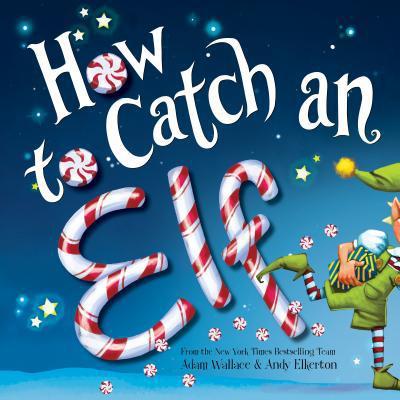
“It’s Christmas Eve! Hip hip, hooray!
Yes, Santa’s coming ’round.
He’s bringing toys to girls and boys
in every house in town.”
“Some kids have tried to catch him,
but Santa’s fast, you see!
So they’ve set their eyes on a smaller prize,
and now they’re after me!”
How to Catch an Elf is such a sweet rhyming book, it can’t help but entrance your little ones and get them giggling. One of the best ways to get kids excited about reading, is making it a fun experience for them. This one is so much fun to read out loud, they’ll ask you to read it over and over again.
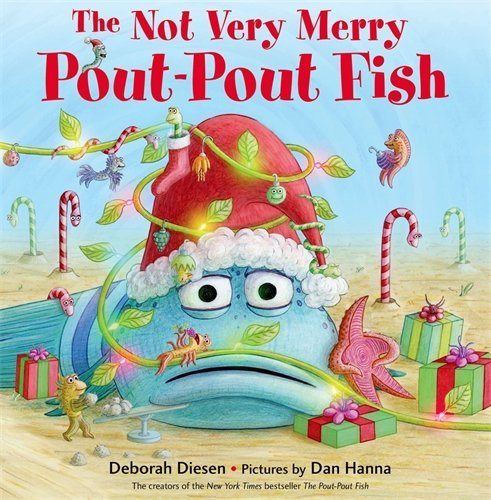
“A gift should be big,
And a gift should be bright.
And a gift should be perfect–
Guaranteed to bring delight.
And a gift should have meaning
Plus a bit of bling-zing,
So I’ll shop till I drop
For each just-right thing!”
I love the Pout-Pout series in general because of the fun illustrations, and this one is quickly becoming one of my favorites. In The Not Very Merry Pout-Pout Fish, Mr. Fish is so busy searching for the perfect gifts on his list, he just might miss out on the most important message of all! This is such a lovely reminder that the best gifts not only come from the heart, but are the ones you give, not receive. Kids are sure to love the story, and parents can use it to help them understand better what gifts represent.
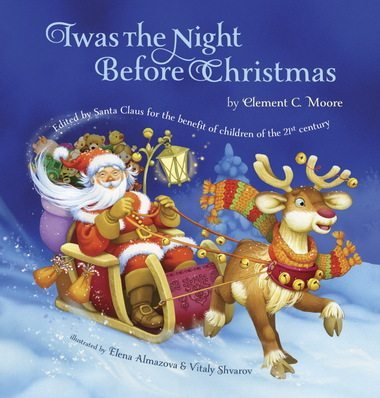
“‘Twas the night before Christmas, when all through the house
Not a creature was stirring, not even a mouse;
The stockings were hung by the chimney with care,
In hopes that St. Nicholas soon would be there.”
There is probably no better-known Christmas book than the poem-based story ‘Twas the Night Before Christmas by Clement C. Moore. There are so many editions to choose from, it’s really fun to browse through them and find the one you like. This is an excellent book to base traditions on! You can create a special evening out of it by having a themed dinner, and getting dressed up in your finest Santa pajamas. It’s great to get the whole family to sit together in a family room, preferably one decorated with a Christmas tree! You can have kids take turns reading sections, or acting out the parts. The best thing is, they will remember it year after year, and look forward to that special night you read it together.
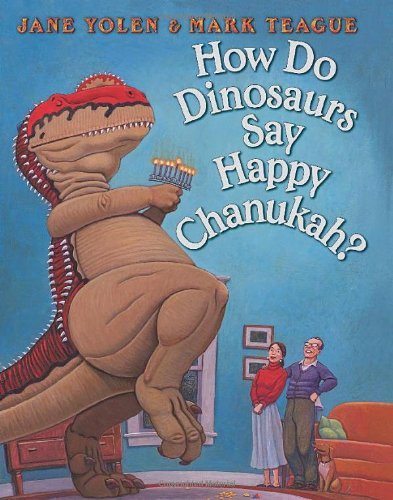
“Does a dinosaur act up on Chanukah nights when mama comes in with the holiday lights?
Does he fidget and fuss through the candlelight prayer?
Does he blow out the candles when no one is there?”
Jane Yolen and Mark Teague’s Dinosaur series is one of my favorite picture book series, one I remember reading over and over again with my son. The illustrations in How Do Dinosaurs Say Happy Chanukah are colorful and warm, and I love the looks on the parents’ faces as the dinosaur acts up through the pages. While the book doesn’t delve too much into the meaning behind the holiday, it does a great job entertaining kids and poking fun at just how hard it can be for kids to sit still during important holiday events.
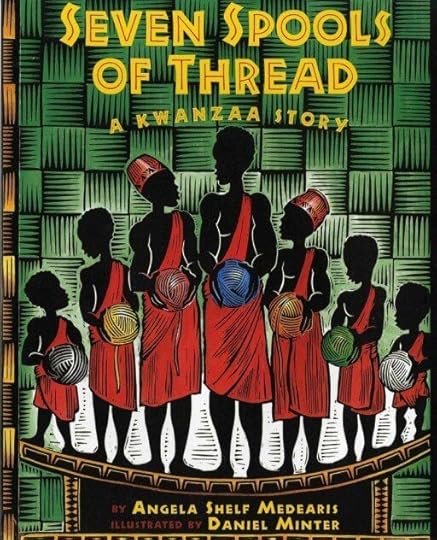
“In a small African village in the country of Ghana there lived an old man and his seven sons. After the death of his wife, the old man became both father and mother to the boys. The seven brothers were handsome young men. Their skin was as smooth and dark as the finest mahogany wood. Their limbs were as straight and strong as warriors’ spears.”
I just love the linoleum block prints that make up the illustrations in the classic fable, Seven Spools of Thread. It is a beautifully written story about how a family must work together instead of fighting amongst themselves, while gently teaching the seven principles of Kwanza, the Nguzo Saba. The author cleverly weaves in all of the Kwanza principles within the story, leaving it to the reader to uncover them. This is a lovely story to share with your kids to help them understand family values, working together, and the many ways we can celebrate family and community.
The post Alane Adams’ Holiday Reading Guide appeared first on Alane Adams.
September 28, 2017
Why I Love Being an Indie Author
I have been an indie author for the past three years. Being a writer was a lifelong dream that came to fruition when my son asked me to write him a book he could read. At the time I began the Legends of Orkney series, independent publishing was really taking off. It offered unlimited opportunity to publish your work without having to break through the hallowed gatekeepers of publishing. I didn¹t yet know very much about the publishing industry, garnering reviews, marketing, even who my real target audience was. Needless to say, it was a steep learning curve.
Since then, I have become well-versed in the business side of writing, and how much writing is really about rewriting. So often an aspiring writer finally completes that long dreamed about manuscript and is sure it is going to be the next big thing. I¹ve learned the hard way that what it takes to be a real author is perseverance. A willingness to revisit your work and hammer it over and over again until it resembles something worthy of print. If I could go back to the beginning, I would delay my first book and work longer on editing it, but I didn¹t know then what it needed. Now three books into the series, I feel like my third book more fully represents the writer I want to be.
I am so grateful for the experiences I’ve had being independently published because it¹s forced me to learn every aspect of the business. Publishing is changing rapidly and being traditionally published is not always the boon it once was. Being able to know and understand the business side allows me to choose my path forward and know that regardless of the platform I choose, it will always be about the quality of the writing.
The post Why I Love Being an Indie Author appeared first on Alane Adams.
May 30, 2016
Finding Inspiration
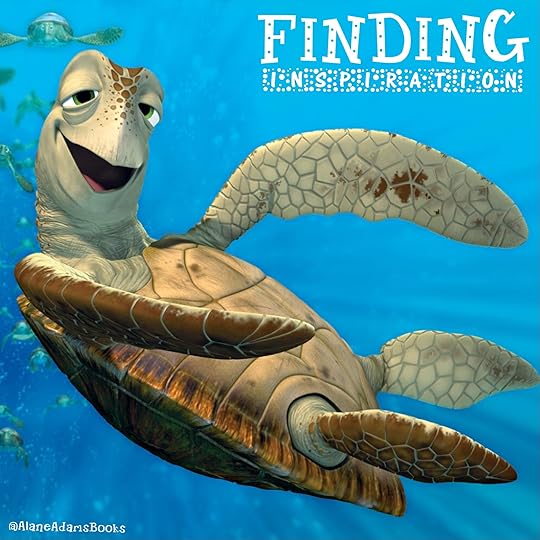
One question I frequently get asked is where do I get the ideas for my stories from? It made me wonder where successful authors draw their inspiration. The answers can be surprisingly mundane!
Believe it or not Stephanie Meyer claims the inspiration for her Twilight series came after she awoke from a vivid dream about an ordinary girl and a gorgeous, sparkly vampire in a meadow having an intense conversation.
JK Rowling had her first idea for Harry while delayed riding on a train (to London not Hogwarts!) then sketched out the first seven books mostly in longhand!
Suzanne Collins wanted to look at war and its costs from the viewpoint of children, and so she developed her Gregor The Underlander series for the very young, and then later, the Katniss Everdeen-led Hunger Games for teens.
Stephen King claims to have gotten inspiration for one of his Nightshift characters from his stint working a laundromat one summer. His supervisor was a gentleman with no hands, only hooks. This image simmered in his subconscious until it bubbled up into a character.
John Grisham found inspiration one day at the DeSoto County courthouse when he “overheard the harrowing testimony of a twelve-year-old rape victim and was inspired to start a novel exploring what would have happened if the girl’s father had murdered her assailants.” Three years later he would publish A Time To Kill.
Perhaps most interesting and mundane of them all, George RR Martin claims to have been inspired to write the GOT series after observing the pet turtles he bought at a dime-store as a child. The turtles lived in their small tanks amid a toy castle he owned and they had the bad habit of dying frequently. These untimely turtle deaths are the reason we had a Red Wedding!
My inspiration is as mundane as the rest. One day, my son asked me to write him a book he could read. I had never considered children’s books before but once possessed with the idea, I couldn’t stop thinking about a boy who had both light and darkness in him. Witch magic and God blood led to my Legends of Orkney series. At the same time, I was fortunate enough to spend time with my 94-year-old father who shared a simple childhood tale of stealing coal from a train when he was a boy. My award-winning picture book The Coal Thief was written in one afternoon in the chair of a hair salon.
Where does your inspiration come from? Drop me a note and let me know!
Alane
The post Finding Inspiration appeared first on Alane Adams.
May 10, 2016
Happily Never After
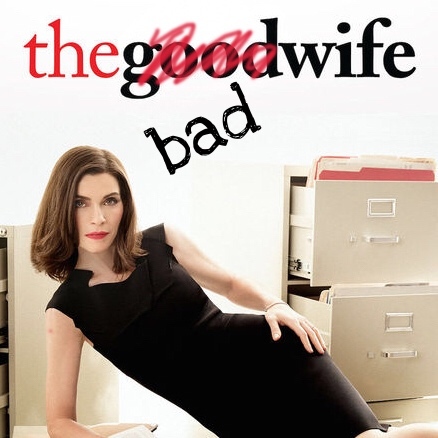
After watching the series finale of The Good Wife, I was prompted to reflect on why we crave happy endings, and why messy unresolved ones leave us feeling deprived and let down. I first wrote about this in a blog post back in 2015. I recalled reading a John Grisham novel that had a terribly unhappy ending. The main character did not get the girl, in fact, he lost everything when she took off with the money and his dreams of a life together. Years later, that book still sticks in my craw because after reading four hundred plus pages and suffering alongside the hero as he traversed his challenges, I was ready to be rewarded with that satisfying sense of redemption, that affirmation of hope that things would turn out okay. Writers make an unspoken promise that no matter how badly they abuse and torment their characters, in the end the protagonist will overcome all odds.
Of course in real life, happy endings are less common and certainly not guaranteed. We divorce, get sick, end up jobless, and fail to achieve our goals. That’s life. It’s one of the reasons we so enjoy turning to the fictional world where we get to escape those harsh realities and rediscover what it means to have hope, to dream big, and to see our heroes triumph. We gain strength when Harry Potter defeats Voldemort. We believe in love when Bella finds a way to be with her vampire. We feel patriotic when we watch an American Sniper be revealed as a warm, caring, loving father and husband. Because American Sniper isn’t fiction, we didn’t get the happy ending our main character deserved, but we can take that hit in our heart because it happened that way and it was a story worth sharing. We grieve and feel for his family and shake our head at how unfair real life can be.
This is why the writers of The Good Wife left so many followers shaking their head in wonderment that after all the years of watching our main character be put to the test, she ultimately is revealed as nothing special, nothing heroic, certainly nothing really worth looking up to. Is that required? No, but isn’t it nice? Two scenes in particular stand out to me in this last episode. In the first, Alicia’s daughter is declaring that she is going to put off college so she can stand by her man, her dad in this case, just as Alicia did all those years ago for him. So, after seven seasons of Alicia charting a new course and having this huge character arc, her daughter basically ends up just like her back where it started, a sacrificial lamb whose own life and needs pale in comparison to the male patriarch who would suffer so greatly (for his own sins and choices) if his family wasn’t there to fawn over him. Really??? It made me want to vomit. Why didn’t Alicia rail against it? Grab her, shake her, say NO DON’T MAKE THE SAME MISTAKE I DID! STAND UP FOR YOURSELF! GO LIVE YOUR LIFE. It’s not that she didn’t try in the moment, but it felt weak, and ultimately she just allowed her daughter to roll over and play the follower. And that was hard to stomach.
The second part was the ugliness in Alicia which was revealed as she shut down Diane, a hardly sympathetic character most of the time, which is why the reversal was all the uglier as Alicia declared they should do whatever it takes for their client, in this case, her husband, a fairly slimy and unlikable guy who may or may not have been guilty. But let’s face it, Peter was almost always guilty of what he was accused of, why would this case be any different? Not that the writers allowed us to find that out. We were deprived of any resolution on just about any front.
So to recap where we stand: Her son is off getting married at nineteen to a much stronger and charismatic girl for whom he has subverted his wants for; his sister has subverted her wants to be there for her father; and Alicia has subverted just about every ounce of character and empathy we had for her to help her smarmy husband get what he wants. Wow, it just felt like the most negative and hateful ending a writer could dream up. Let alone, the fact so many other story lines were ignored so that her dead boyfriend could be brought back. Sure, nice to see Will, but no farewell to Michael J Fox? To the rest of the firm members? Luca? Nope. Just a resounding slap in the face. All I can say to the writers is well, you sure showed me that you can do whatever you want. You have the power to give an audience an uplifting ending or a complete downer. You went with downer. Some might admire the boldness, the way Alicia ended up being more like her husband than she ever anticipated. That may be just fine for a lot of the audience. But I still believe the following:
Fictional stories are meant to transport and uplift us, restore a little bit of hope to our soul so that we can carry on the fight we each shoulder every day. I believe we watch and read stories to be taken on a wonderful challenging ride filled with crazy ups and downs, soaring highs and lows, secure in the knowledge the writer will somehow deliver us to a safe place. That our protagonist will be okay. That’s the reason Jon Snow lived when so many other beloved GOT characters died. We desperately needed to have that sliver of hope to hold onto. I wonder if this is just the new normal in our modern story-life, where writers no longer feel compelled to deliver hope. As if its cliché and old-fashioned to believe in something bigger than ourselves. I, for one, long for the stories that hold out their happy ending until the very end, making it all the more satisfying when we get it. As an author of children’s books, I feel it is important to deliver on that promise. Children most of all need a safe place to escape to where they can be witness to the challenges life has, and be given a sense of hope that if Harry can defeat Voldemort, maybe they can survive middle school.
Alane
The post Happily Never After appeared first on Alane Adams.
April 16, 2016
Still Waiting to Be Published? Ten Things You Can Do Today To Feel Like An Author

One of the most frustrating thing for aspiring writers can be claiming the title of author. If Harper Collins hasn’t come calling yet, and your completed manuscript is buried deep in a drawer, or languishing in slush piles, are you really an author?
Even self-published authors struggle a little with the question that inevitably comes up.
“Have you been published?”
“Yes, I have.”
“Oh, who’s your publisher?”
“Me.”
Squirm.
For me, writers write, but authors, they’re published. That’s what separates the two titles. That holy grail of a big name publisher who actually pays the author for their work. So how can we find ways to build our confidence while we’re still in that limbo stage? Here’s a few ideas you might try.
• Join a writer’s group and hang out with some peers. I should take my own advice. I haven’t belonged to a group in years, but I miss the camaraderie and kindred spirits. Just to be able to sit around and talk about writing!
• Send out five query letters this week. You’re not legit if you don’t submit! Rejection is just part of the process. A steady stream of them may mean you need to work on your craft. Keep polishing and improving, but don’t give up.
• Review your social media plan, or put one together if you don’t have one. What platforms are your readers on? Tweens and teens are using Instagram and Snapchat more than Facebook. Build connections with other writers. It’s so easy to build a network of followers on Twitter by getting on a few author’s lists and using a follow/follow back method. If nothing else, you will get connected with other aspiring authors and find a community that welcomes support.
• Begin planning your next novel. Do some research on the subject you want to write about. Create a character list. Thumb through the phone book for interesting names. Cut out pictures (or print them off the internet) of who your characters look like. It helps bring them to life and makes it easier to describe them. Make a list of unique traits and assign them to your characters.
• Make plans to attend a writer’s conference in your genre. There are so many great ones out there. If you are a children’s author, you should belong to the SCBWI (Society of Children’s Book Writers and Illustrators) and attend their regional and national events. There are also conferences for mystery writers, romance novelists, and, you get the idea. There is one for you somewhere.
• Attend a conference, but don’t just sit in your chair, socialize, talk to people. They are your peers, the people who, like you, are trying to make headway in this industry. Best of all, you will have a few new friends to share your journey with.
• Write the back cover copy for your soon-to-be-published novel. What’s the headline? Mine was “Percy Jackson Meets Norse Mythology”. Come up with a catchy, irresistible set of paragraphs that puts your manuscript in the best light. Imagine what the blurb from Foreword Reviews will say, or the starred Kirkus review you’re going to get. What taglines will they use to describe your story?
• Take a red marker to one of your favorite novels and circle all the things you like. Interesting metaphors. A quirky turn of phrase. A setting description that stands out. Make notes in the margins and dissect it. I do this with George RR Martin’s novels. The man is a genius at metaphors. Try to get into the author’s head to understand what they were doing, and see how it can inspire you to raise the level of your own writing.
• Read Stephen Kings’ book on writing, or my favorite, If You Want To Write, by Brenda Euland. A lovely classic that encourages and supports every aspiring writer.
• Write. Because that’s what real authors do.
Do you have your own list? Share it with me. And do keep writing with an iron jaw!
Alane
The post Still Waiting to Be Published? Ten Things You Can Do Today To Feel Like An Author appeared first on Alane Adams.
April 8, 2016
Top Twelve Amateur Writing Mistakes
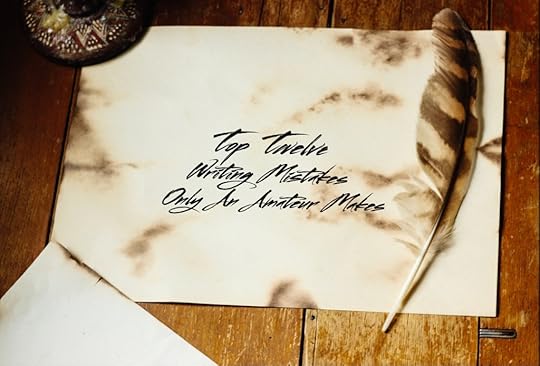
Imagine finishing your first novel and proudly showing it off to an agent, hoping that lightning will strike and your fabulous talent will be discovered. The problem is your fabulous manuscript is riddled with amateur mistakes that could easily be fixed, allowing the gem that you created to shine through and convince agents and editors you’re the real deal. How? By applying a little elbow grease up front and sticking to the guidelines laid out here.
So here are my Top Twelve Amateur Mistakes Writers Make:
Overuse of I said, he said, she said. Your manuscript doesn’t need them. Cut out half of them, and then cut out another half and your manuscript will start to have lift off.
Repetitive phrases. Use a software program to check for repeated words. You will be shocked how often you repeat the same word on a page. Overuse of identical words shows a limited range of skill in detailing events in your story. There are programs that will do this for you fast and easily, so invest in one and make your manuscript start to zing! (I use ProWriting Aid but there are many out there!)
Typos. Don’t have any. Period.
Not replacing backwards, forwards, towards, upwards, downwards, with backward, forward, toward, upward and downward.
Overusing (insert pronoun) heard, saw, felt, realized, seemed, had been. Use the word search function and count the number of times you use each of the listed words. You will be shocked at how much you overuse this method of describing your character’s actions. Replace as many as you can with active descriptions. I heard a shot fired, is more exciting when it’s written as a shot zinged over my head making my ears ring. I felt a bolt of fear can be better stated as fear ripped through me like a bolt of ice.
Did I mention typos? They’re there. Find them, including bad punctuation and missing periods.
Overuse of backstory and flashbacks. Eliminate them whenever possible. Stories are best told in the present tense. Flashbacks and prologues are a bit like cheating. Find a way to weave the backstory into the present and your editors won’t get annoyed with you.
Buying into the family and friends bandwagon who claim your novel is the best they’ve ever read. They are biased, even when they say they’re not. They can’t see the forest for the dangling participles. Don’t believe a word they say. Find a good editor who doesn’t see you on Thanksgiving Day and pay for as much criticism as you can take. The only way you will grow as a writer is to hear feedback which is impartial and informed.
Wallowing in self-pity when your manuscript gets rejected. This business is very subjective. Your manuscript might be great, it might be average. Doesn’t matter. The only way anyone will ever read it is if you make it worth reading. So don’t wallow, work harder at learning the craft and develop a thick skin.
Working on the same story over and over for ten years thinking that the first book is so precious it has to sell before you ever write the second one. Don’t linger in the past. The first book might have been your best, it also might have been an exercise in Can I Do This? The answer is yes, now send it out to get edited by a professional while you write the next book. Don’t wait around hoping lightning is going to strike. It probably won’t. But if you start the next book while the first one is in the hopper getting edited, then pretty soon you’ll have two books, and when that happens, your confidence will increase and with proper feedback, your writing will begin to improve. Then you just might climb out of the amateur stage into the up and coming author stage.
Writing a book that is 500 precious pages long! Unless you really are the next George RR Martin cut it down to 80,000 words and you might find an agent who will read it. If you don’t think it can be done, start taking out secondary story lines and see what happens. If that doesn’t work, try removing a sub-character and see if you can trim the story.
Having a query letter that begins with “All my friends think this is the best book they ever read!” Or even worse, “This book is the next (fill in blank) Harry Potter, Game of Thrones, Twilight.” Tell the agent what is unique about your story. Convince them you have a twist that hasn’t been done yet and they might ask for a few pages. DON’T send your entire manuscript with the query. Be careful to read their submission guidelines and follow them. You are not special, and your work won’t be seen as such if you pester them or try to step out of their guidelines because you’re convinced your manuscript is unique. The work will speak for you, so let it.
Remember, keep an iron jaw, and always keep writing!
PS: After travelling all week to Denver for the annual Public Library Association, I thought I would share a repost of one of my favorite blogs from 2014, updated with a few lessons I’ve learned along the way. I hope you enjoy it!
Alane
The post Top Twelve Amateur Writing Mistakes appeared first on Alane Adams.
April 1, 2016
The Art of Writing a Great Series

Imagine sitting down one day and thinking up an idea for a series that would take over two million words to write…How would you convince readers to come back book after book, year after year, and remain as avidly committed to the story line in the last hundred words as they did in the first? You need go no further than George RR Martin’s epic Game of Throne’s series for the answer. Another great series, Harry Potter, consumed more than a million words. How did these authors create a story arc that could survive such a long and complicated journey from start to finish?
Let’s start by comparing these two series. The basic rule for a great story is creating a main character that can carry the series. What does your protagonist need to do that? An enormous character arc to traverse in order to get to where they need to be. This usually means they start out completely clueless, unaware of their own power, whether magical or metaphorical. Mystery swirling around a secret past helps. Perhaps a backstory that makes your hair stand up, blood run cold, or just leave you wanting to weep.
We see that clearly in Harry Potter, the boy who lived. When we encounter him first, he is unaware of his own powers, living in a cupboard under the stairs. He has no idea how he got that scar on his head, or why someone would be sending him letters. In contrast, Game of Thrones relies on multiple main characters, (most of which get brutally killed off at some point). Just when you think you know who the hero is, they get their head cut off, or they are stabbed in the back by their own comrades. (Is Jon Snow alive or dead…you tell me.) I think it’s part of what makes the series so great. The characters we expect little of, like the weepy Sansa, the crippled Bran, and little sister Daenerys, end up clawing their way bit by nasty bit up a very long ladder to grab their power.
Character growth is essential to a good series which means the characters must start at the bottom and climb to a worthy finish.
A second rule of a great series is to keep an underlying unifying thread that unravels page by page. A mystery, a puzzle, that is being slowly revealed, one impossible to see what shape it forms until the puzzle is completed. The greater the mystery, the greater the cost of each reveal, the more punch the story has. Harry Potter is a great example of this. Throughout the seven books we never really see Voldemort fully revealed until the finale, and then the epic battle must take place, and the series ends because the puzzle is solved.
With Game of Thrones, we get multiple story lines, multiple character arcs, and part of the challenge is deciphering just who the books are about. It’s like we instinctively search for the protagonist to root for, but Martin does such a great job entertaining us, when we are constantly proved wrong, we don’t care, we just keep turning the pages to find out who ultimately will win the game. Because that seems to be the unifying thread throughout the sagas: who will claim the Iron Throne. Every game has a winner. Martin is able to pull off an incredibly complex story by moving inexorably closer to an ultimate conclusion that seems destined to have his surviving main characters ascend to power.
Question: Do you think Martin knew the ending to the series when he sat down to write it? When I started writing my Legends of Orkney series I had NO idea how the series would end up because I hardly knew my characters and my realm. It took writing the first three drafts to begin to understand the nuances of that underlying thread and go back and weave it in tightly to the story.
I think a third important rule for series writers is to know what kind of story you are writing and stick with it. A great example of that is the Twilight series. It made no bones about being first and foremost a YA romance between a beautiful vampire and an ordinary girl. Everything else swirled in the background. Game of Thrones is clearly epic fantasy. No deviating from that. Harry Potter was interesting because while it started more middle grade, it shifted toward YA as the series matured. Characters died. Harry is physically tortured. Heavy stuff for tweens. But ultimately, the series kept its focus on Harry and because he was getting older, and the readers were too, it seemed an acceptable shift.
Those are just three of the things I think are important. What do you think is an essential part of a great series? Let me hear from you.
Until then, keep an iron jaw. And always, keep writing!
Alane
The post The Art of Writing a Great Series appeared first on Alane Adams.
March 25, 2016
Review of “Heir of Fire” by Sarah J. Maas
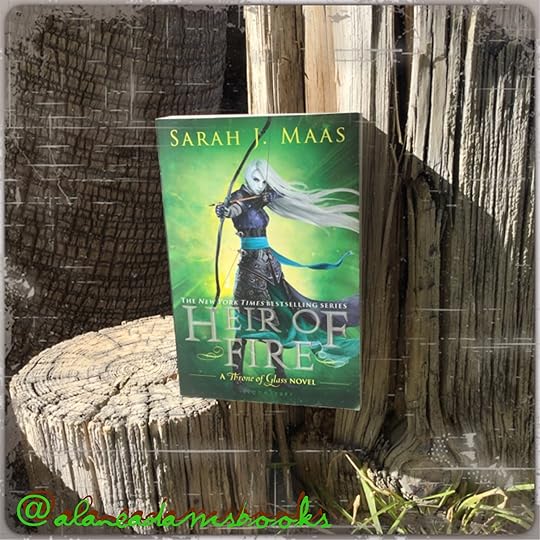
After finishing Crown of Midnight, I was really excited to leave Aderlan behind (finally!) and have Celaena explore more of this magical world Maas has beautifully created. I knew I would miss the interaction of Celeana with Chaol and Dorrian, but I was growing tired of her need to emotionally flog Chaol for Nehemia’s death when essentially Nehemiah set it up. But instead of opening the pages to find Celaena on an adventure, we find her in a drunken sprawl on a rooftop, drowning in self-pity and doing…nothing. Kind of a letdown. Not sure why Maas chose this opening, but it definitely gave the book a low emotional start for me.
When Celaena encounters a mysterious person, things start to pick up as she is brought before her Aunt Maeve, a cruel and ultimately, despicable relative. Celaena is ordered to master her powers before Maeve will share any secrets about the wyrdkeys. Thus begins hundreds of pages of training and brutality between her immortal fey warrior tormentor, Rowan Whitethorn, and Celaena. Page after page of Celaena filled with self-loathing and such a low opinion of herself even Rowan agrees she’s not worth keeping alive. After a few rounds of Celaena lashing out and insulting Rowan, and Rowan punching, taunting, and horribly shaming Celaena back, I wanted to smack both their heads together. But finally, as Celaena inched her way toward accepting and understanding her powers, Rowan started to grow on you, and became one of my favorite characters in the story, (probably because he’s one of the few that never wallows in self-pity). I did find his sudden compassion after seeing Celaena’s whipping scars a bit much. He had been through as much himself, and to suddenly have so much compassion for her after showing so much contempt, seemed one of the few character movements for Rowan I found abrupt and artificial. Their friendship deepens over time and for me, it is one of the best parts of the book. (I worry Maas will turn it into a romantic one as it seems to tilt that way at times.)
I’m so glad we finally got all the memories out of the night Celaena’s parents were killed! It has been dragging on for three books now, always hinted at, but never fully explained. Hopefully, now Celaena has faced the darkness of her past, she can become a leader, stop running and make a stand for her people, which is ultimately what we root for the most.
My Biggest Pans:
As much as I loved the addition of Manon and her Thirteen, and the evolution of her relationship with her wyvern, the story line served NO purpose to advance Heir of Fire. It had absolutely no connection to the plot of this book’s arc, and could have been completely excised from the novel and there would have been no effect on the outcome for any of the main characters. I have a problem with an author inserting an elaborate story line into a book that doesn’t pay off in the slightest in that book. In fact, Maas goes so far as to ignore the Manon-story line she had been weaving in regularly for over 200 pages straight, before bringing her back into the story at the end. By then I had nearly forgotten the players, and why I should care. It felt like it belonged in the fourth book, but maybe Maas didn’t want to take the time in that book to let those characters build up, but wanted them ready to draw on. Not an excuse, in my view, to splice it into Heir of Fire.
My second biggest pan is, even though this is YA, and drama is to be expected, a lot of the drama is overwrought in the characters, forcing them into making bad decisions or decrying their unworthiness. Celaena was a child when her parents were murdered, but she is filled with so much self-loathing over the incident and aftermath, it gets a little trying, especially when all magic is banned, and there was little she could have done. She further beats herself into a pulp (and blames Chaol) over Nehemiah’s death when even Celaena herself accepts Nehemiah chose to sacrifice herself, so her refusal to forgive Chaol, or herself, just makes her look foolish. It felt more like an author’s decision, not the character’s decision to continue to hold onto the angst, when the reader knew it didn’t really hold up.
Without Celaena there to ground them in a scene, the main subcharacters seemed to spin in the wind. Chaol turns into a complete mess, indecisive and filled with angst, while Dorrian spends the whole book trying to hide his powers instead of mastering them. Speaking of Dorrian, his love interest was…meh. When she died I was…meh. I didn’t really ever understand his passion for her, or feel like they had a strong connection, and the brutality of her murder just served to push his character toward another Maas-designed goal. I did like Dorrian’s growth in the way he stands up to Chaol, pushing his once-close friend to choose sides.
Other thoughts:
Aedion turned out to be a nice surprise, though his adoration for Celaena was a bit creepy and over the top.
The King of Aderlan remains an undeveloped character for me. He gets very little page time, simply a threat in the background, ever present, but hardly ever in the scene, with few exceptions. His assassin has been gone for months but no one seems to check up on her, to see if she has done the job he sent her to do.
Do we really need three names for our heroine: Celaena, Alian, Elentyia…
Favorite new character: Rowan Whitethorn was one of the more interesting additions. Brooding, cold, distant, brutal to say the least. But ultimately a loyal and faithful friend. The lessons grew tedious for me, the amount of time spent training and getting nowhere. I wanted there to be progress faster, and it seemed like it took forever for things to change. Things picked up for me once her powers were under control and their closeness became a reason to turn the page.
Favorite scene: When Celaena faces Maeve and gets her to give up Rowan. Amazing tension and excellent setup.
Favorite line: I claim you Rowan Whitethorn…
Overall, while it’s easy to pick on things, I really love Maas’ writing and I hope the next installment moves the story forward in a way that makes all this waiting payoff.
I rated Heir of Fire three stars because of the over dramatization and inclusion of a subplot that had no role in the book. I think if Maas had toned it down a bit on the self-loathing, and found a way to connect Manon’s story, it would have been a five star read. By the third book, I guess I just hoped for more.
Next week, look for a blog on writing the perfect series!
And remember, keep an iron jaw. Always keep writing, even when the critics sling their arrows.
Alane
The post Review of “Heir of Fire” by Sarah J. Maas appeared first on Alane Adams.
March 17, 2016
The Writer’s Promise

If you’re an author, there is nothing more exciting, or daunting, than starting a new book. It’s like stepping onto the deck of a ship and heading out to sea for an undetermined amount of time. Months, maybe even years. You step on board, prepared to invest your heart and soul into the characters you will meet, and agree to assume the heavy burden of determining their fates. You make a commitment on that first day, like any good captain, that you will see the voyage through. That you will not dive overboard when writer’s block strikes and leaves you dead in the water. You take an oath you will not give up the ship when all seems lost and there is no publisher in sight. You silently swear you will not abandon these characters you have given life to until you have seen them through their arduous passages to their safe harbor.
That is the writer’s promise.
But what is the best way to go about it? Some authors create an outline, a roadmap to their story before they ever put pen to paper. These wise novelists exhaustively research their story, blocking out every character and plot point chapter by chapter until the complete skeleton of the book is completed.
Oh, how I envy those writers! I wish I had their discipline, but I can’t help myself. Once I get an idea and sprinkle in a few characters, it’s like I have to dive in headfirst and go! I’m in love, and I want to spend every second voraciously discovering the story first hand. Who is this amazing hero with all his or her warts and flaws? What is this enticing world I want to immerse myself in? Tell me, tell me, what is going to happen next??
But those other writers, the ones who have a strong outline, they’re probably far ahead of writers like me. They know where they’re going before they dive in. They can confidently find their way chapter by chapter with steely precision, knowing up front that their story makes sense, and the big moments are there, character arcs complete (Insert envious sigh). For those of us undisciplined writers, we have no roadmap, just a keen sense of story, and a precious kernel to plant and carefully nurture into life. For me, that means I start on page one and write in a linear fashion from the beginning all the way to The End figuring it out as I go along. Of course, I still do my research, and am always thinking about every twisting turn and back road I will take, but I don’t sit down and make a plan. It also means on occasion I have to go back and take out a plot point or two that doesn’t pay off, or weave in a thread that I later discover I need.
So which method is better?
I have no doubt that being organized and investing time up front in developing the character arcs, backstories, and setting is a much better way to do it, especially if you are world building. So why don’t I? It’s not because I lack discipline or structure or knowledge. No. I think it’s because even when I’m writing, I’m also a bit of a reader, not wanting to know the road ahead. I want to discover it as if I were reading it as I am writing it, to keep the mystery and magic of the story intact. I remember writing a scene in Kalifus Rising about a character who I had definitely envisioned dying in a later scene but suddenly, as we were crossing an open field, arrows flew, his body contorted, and he literally died in front of my eyes as my fingers flew over the keyboard. No one was more shocked than I. No! I cried. You die much later. But there it was, his body lay still and cold, riddled with arrows. And there was no way I would change it because it was just…right. And that’s why I love being a fly-by-the-seat-of-your-pants author. I get to discover the story as I’m writing it.
Still, I have learned that if you are going to create a six-book series, you should really put the time into setting up the major, and I mean, BIG plot points that you want to hit so that the series hangs together and has that overall rising action you need to make the reader follow you through book after book.
But however you do it, above all, keep an iron jaw. Don’t let the critics get to you, or the doubts, or the cynicism. Just. Keep. Writing.
Alane
PS Next week look for my book review of Sara J Maas’ Heir of Fire!
Art by Eksafael DeviantArt.com
The post The Writer’s Promise appeared first on Alane Adams.



